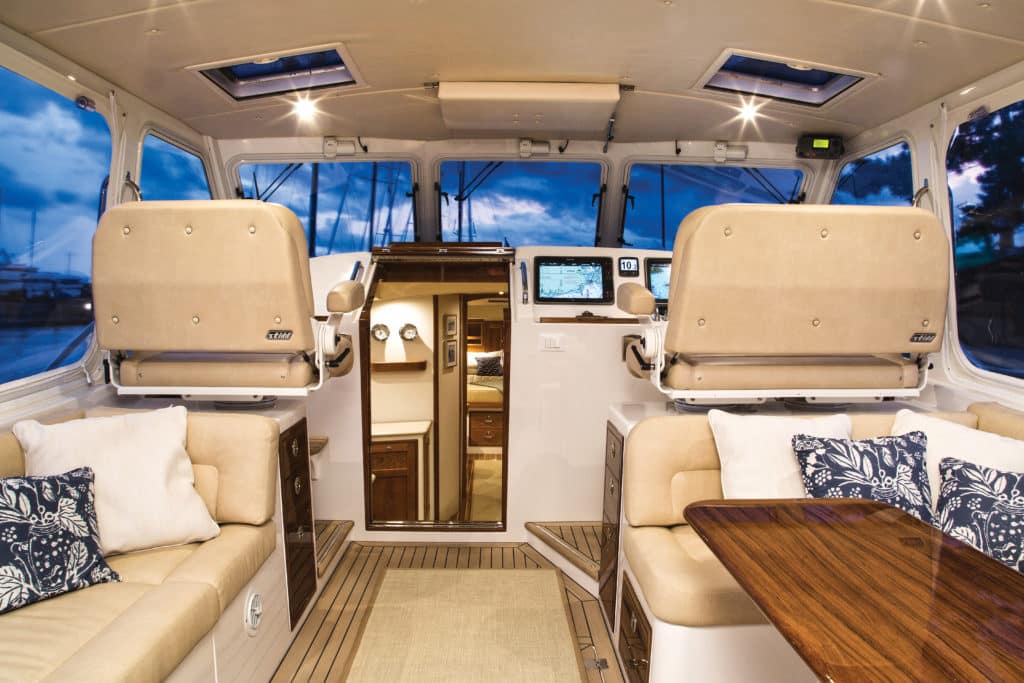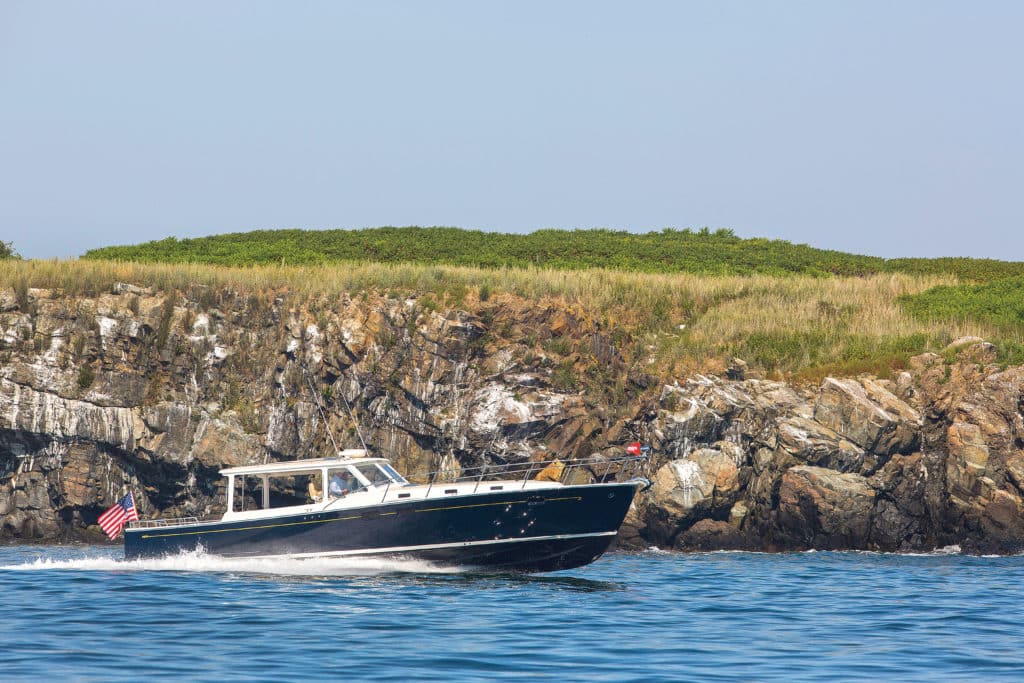
The MJM 50z is a thought-provoking yacht with some impressive firsts. It comes from the first builder in the world to make a Seakeeper gyrostabilizer standard. It’s also the first U.S. production powerboat with high-tech epoxy and composite construction. It has a single-level deck spanning nearly half the yacht’s length, plus speed (33 knots) with fuel economy (around 1 nmpg at 25 knots). It not only meets but exceeds the Category A Ocean requirements, the highest seaworthiness rating from the International Marine Certification Institute. Designed for owner-operators who like to cruise, the 50z has two staterooms, two heads and an all-weather cockpit. She is a yacht that puts fun and family at the forefront.
Stable as a Table
The MJM 50z is the first production yacht in the world to offer the Seakeeper gyrostabilizer standard. The Seakeeper not only minimizes rolling by day, it also makes for better sleeping at night. A bonus is improved fuel efficiency because the gyro keeps drag-inducing chines out of the water. Rather than taking up valuable engine-room space, the gyro on the MJM 50z is in the all-purpose utility room, along with a washer and dryer.
Built Like a Boeing
After Doug Zurn penned the yacht’s lines, the MJM team went to Boston BoatWorks, which creates offshore racing sailboats as well as America’s Cup yachts and high-performance catamarans. The essence of the 50z’s build was similar to what those yachts require: light weight with superior strength.
“It amazes me,” says MJM founder Bob Johnstone, “that no major production powerboat brand has picked up on epoxy composite construction for better handling, performance, fuel efficiency, seaworthiness and longevity.” The basic construction of the MJM 50z is the same as the technique used for the Boeing Dreamliner 787.
The lamination is E-glass, Kevlar and Core-Cell, utilizing a prepreg process with epoxy resin; it’s then vacuum-bagged and post-cured in an oven. This creates a stronger yacht with less drag, a lower center of gravity and better horsepower-to-weight ratios. Some 50-footers tip the scale at more than 50,000 pounds, while the 50z has a half-load displacement of 32,850 pounds. This type of result is why Ford put an aluminum body on the top-selling vehicle in America, its F-150 truck: better payload, fuel efficiency and longevity.
“The basic construction technique on the MJM 50z is the same one used for the Boeing Dreamliner 787.”
About the “z”
While seeking a designer in 2002, Johnstone brainstormed with his son, Peter. “I asked, ‘If looks are the No. 1 priority, which powerboat designer has the best eye for drawing a pretty boat and pulling this off?’ We both simultaneously answered Doug Zurn, based on the Shelter Island 38 for singer Billy Joel. I called Doug, and, after a month and 14 exchanges of drawings and sketches back and forth, we arrived at a unique signature look needed for a U.S. design patent.”
Zurn created the lines of the MJM 50z to be ageless and classic. She looks, as a recent boat-show visitor noted, “as though she was launched at a Maine boatyard 50 years ago, yet she is advanced beyond most of the latest yachts.”
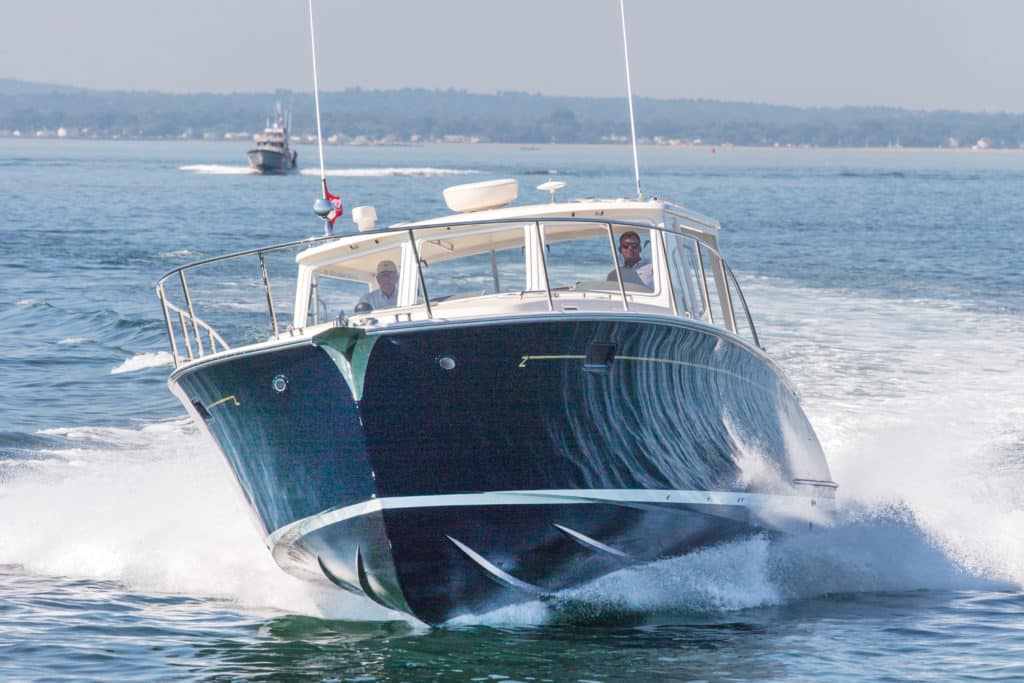
For Short-Handing
The MJM 50z is designed to be handled by a couple. A single-level deck runs from helm to stern. More important, it includes port and starboard boarding doors at the height of floating docks, allowing crew to step off to handle lines without climbing over the side deck and gunwale. Add the nimble handling of the Volvo Penta pod drives with joystick (including dynamic position system hovering) and you get no-sweat, close-quarters maneuvering.
Another benefit of the single-level deck is that the salon is just two steps down, rather than the traditional four or more, and kids can be seen no matter where they are in the cockpit.
Open or Closed?
The MJM 50z’s bridge deck can be enclosed with Strataglass for a finished appearance, so the sides and aft door can be left open on nice days. Three forward windshields open electrically, turning the 50z into a big runabout. The yacht can be buttoned up with air conditioning on warm days or heating to stretch the season.
Power to the People
While the first MJM 34z had a single diesel with bow and stern thrusters to ease maneuverability, the 50z comes standard with a pair of 435 hp Volvo Penta IPS600 diesels with pod drives, giving her a top speed of more than 33 knots and a comfortable cruise of 28 to 30 knots. Want more oomph? She can be fitted with triple 435 hp Volvo Penta IPS600s, pushing the top speed to more than 40 knots with a 35- to 38-knot cruise.
Interesting fact: The twin-engine 50z, when dropped back to trawler speed of 7 to 8 knots, burns just 2.5 gph, offering a 1,400-nautical-mile range with a 10 percent reserve. That’s enough to cruise from North Carolina to Bermuda and back.
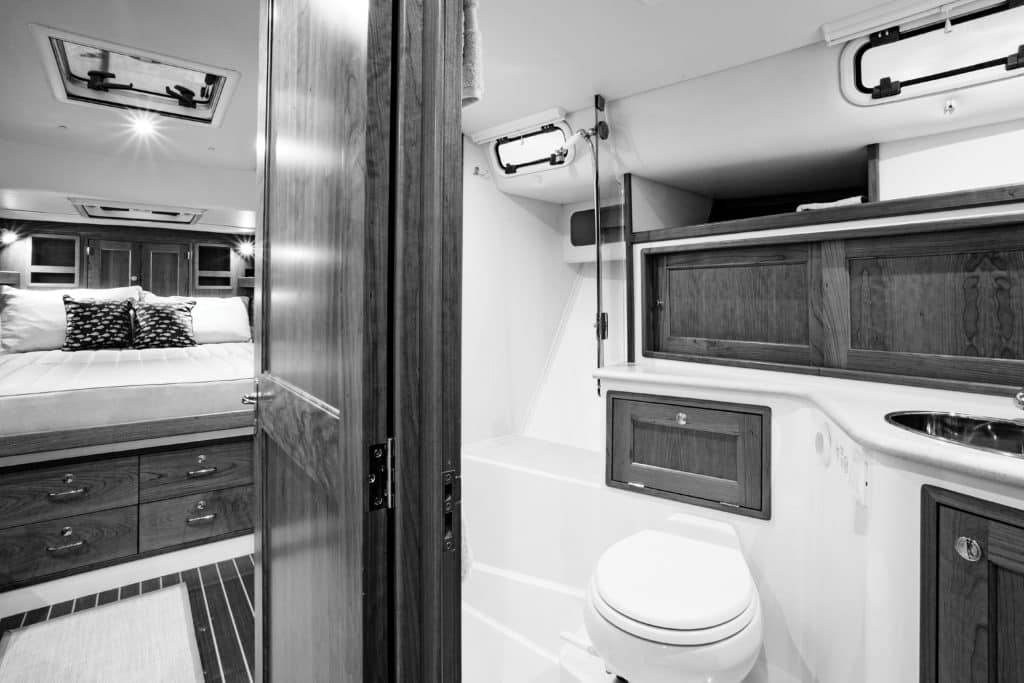
Stowage Galore
Stowage is always a challenge, but, being sailors, the Johnstones worked to create stowage that can only be called “crazy good.” Start with the utility room under the cockpit, which easily handles separate washer and dryer, plus the Seakeeper, plus enough life jackets for everyone aboard. The cockpit settees hide lockers deep and large enough to handle full-size bicycles, golf clubs and inflatable dinghies. Under the cabin sole are four stowage areas with organizer plastic bins to handle dry stores, airline bags, drinks and tools.
The J Factor
Johnstone founded J/Boats in 1977 with his designer-brother, Rod. It remains the leading builder of performance sailboats in the world, with more than 12,000 sailing in sizes from 22 to 40 feet. More than 5,500 of its J/24s have been built, and they have been sailed by people in 30 countries. The Johnstones’ goals of seaworthiness, performance and ease of handling now carry over into MJM Yachts.
The success of J/Boats has even been taught at Harvard Business School as a case study. To date, 17 J/Boat designs have been awarded either Boat of the Year or American Sailboat Hall of Fame honors. Many of the boats racing at major race weeks in America are J/Boats.
The Johnstones had discussed creating a J/Boats powerboat since they both owned small powerboats, but they deferred to working on new J sailboat development. The turning point was when Bob Johnstone’s son, Peter, had success with his Gunboat catamarans. At the same time, Bob had transferred his Southeast J/Boat dealership to Teddy Turner Jr., so Bob had time on his hands. The result was the first MJM 34z.
Power-Cruising Club
Bob and Cathy Hesse switched from sailboats to powerboats with an MJM 40Z.
Yachting: Why did you make the switch?
Bob Besse: I just got burned out and wanted something different. Plus, this boat only clears 8 feet, so you don’t have to wait for too many bridges. As a sailor, that’s something I really appreciate!
Y: Where do you keep the boat?
BH: We keep it in Key West in the winter. Next, we’re taking it to the Bahamas, and then we’re putting it on the trailer and driving it up to Lake Ontario.
Y: What other features do you like about it?
BH: It’s a pretty open layout, so it doesn’t feel like I’m driving the boat in my living room. I didn’t want that. I was a competitive sailor for 15 years, so I like feeling connected to my environment.
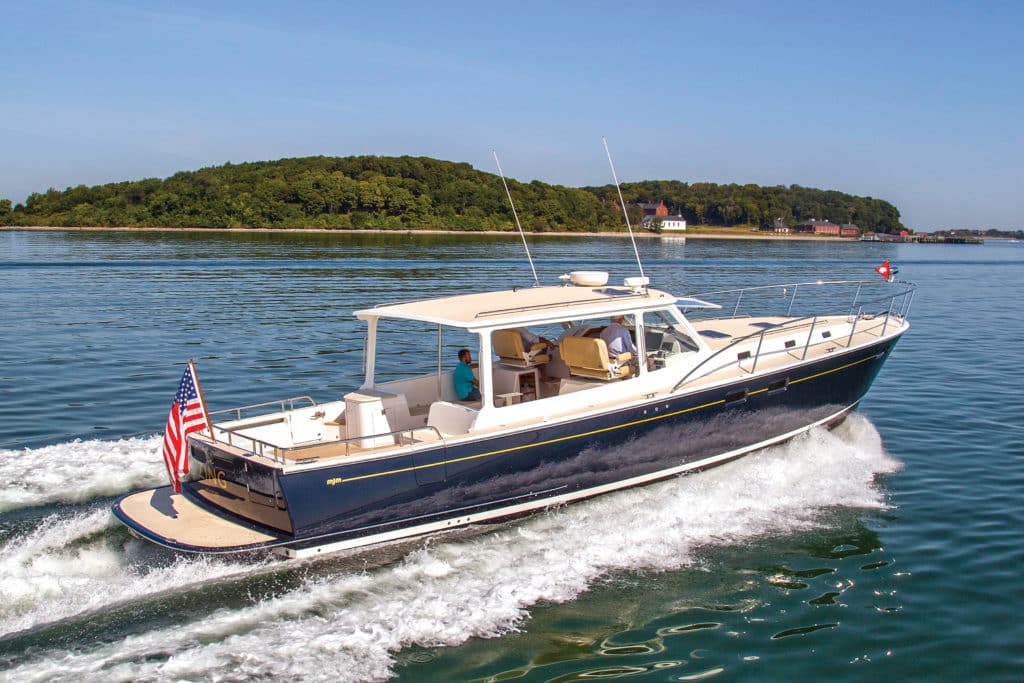
Two, Four or More
The layout of the MJM 50z is as innovative as the rest of the yacht, starting with a master stateroom forward with desk, easy chair and en suite head with glass-enclosed shower. Note that the memory-foam berth is wider than a king berth. The salon has a settee that converts to a nearly queen-size berth and has a curtain for privacy, with access to the day-head and its stall shower with glass door. An interesting option eliminates the need to choose between an open layout and two fixed staterooms, with removable, stowable bulkhead panels that can be set up in a few minutes (they lock into place) to create an enclosed “instant” guest stateroom with its own door. Add a second door to the day-head, and owners have an en suite stateroom for guests.
A permanent second stateroom can also be built in this area.
Need more accommodations space? The 50z doesn’t try to fit a claustrophobic cabin under the cockpit. Instead, the pilothouse can be converted with privacy screens into an air-conditioned and heated stateroom, with either a nearly queen-size berth or a generous single.
What Does MJM Mean?
MJM President Bob Johnstone and his wife, Mary, had enjoyed racing and cruising sailboats for decades. In the mid-1990s, Bob presented Mary with a 29-foot Dyer powerboat as a 40th anniversary present. They used the Dyer to extend their boating season in Maine and explore Boothbay Harbor’s coves and rivers. While still building high-performance sailboats, Bob and Mary came to enjoy the powerboat lifestyle, and he started thinking about building powerboats with the sensibilities of a sailor.
The result in 2002 was a 34-footer that they called “Mary Johnstone’s Motorboat.” Thus the company name: MJM.
